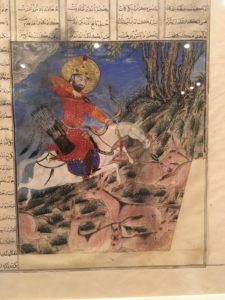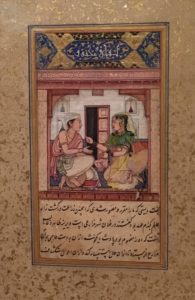The middle of Massachusetts can tend to get lost: Boston is an obvious destination for long-distance tourists and day-trippers, and western Massachusetts boasts various museums and performing arts venues, complemented by lots of lovely outdoor spaces. In the center of the state, Worcester Art Museum (WAM) is a relatively hidden gem in the revitalizing city of Worcester (soon to get its own minor league Red Sox team). The museum beckons for a medievalist road trip to its “Preserved Pages” exhibit before it closes 6 January 2019.
WAM’s manageability is just one of the many reasons to love it, and like most of the galleries and exhibits, “Preserved Pages” occupies a relatively small space that is intellectually and emotionally accessible (as opposed to the somewhat overwhelming experiences of more gargantuan museums like the Met). The items on display are all single-leaf illustrations that came from more substantial books or albums; they are divided into a number of sections (women at court, illustrations from the “Book of Kings”).
The medievalist in me gravitated to the earlier works, of course, although the exhibit as whole forces westerners to question the very periodization that divides “medieval” from “early modern.”
This watercolor from the early fourteenth century, Bahram Gur Hunting Onagers (wild ass), shows Chinese stylistic influence on Persian visual arts; it also depicts a universally recognized heroic king. I love the fur tails (lynx? gray leopard?) attached to the king’s hunting gear – and the museum has thoughtfully provided hand held magnifiers to allow visitors to study detail like the intricate patterns of the king’s robe and boots.

My favorite item in the exhibit, however, dates somewhat later: the c.1580 “Conversation between a man and a woman,” a watercolor from the Mughal period. The gold-flecked paper frame is exquisite, and the image itself finely detailed (thanks again to those magnifiers!).

The figures sit in a beatifully enclosed architectural space. They look at and gesture to each other — the viewer becomes voyeur to this intimate and thoughtful moment. This conversation is peaceful and positive; the expressions on both faces are welcoming and empathetic. The artist has shown us here the moment before the couple’s hands touch, as they are about to make physical the connection already established by their eyes and their faces.
WAM obtained many of these items through purchase in the first half of the twentieth century. They are rarely on display, because of their fragile nature and also because of the highly specialized expertise needed to create an exhibit like this one (which is co-guest-curated by a Harvard graduate student in art history and a Harvard professor of Islamic art). WAM has provided a rare and important opportunity to see these intrinsically beautiful works that also productively disrupt Euro-centric notions of history and art. As I said: the exhibit closes 6 January.
